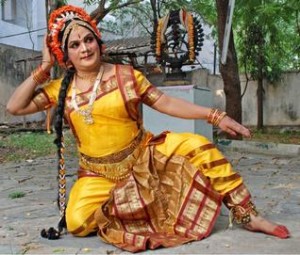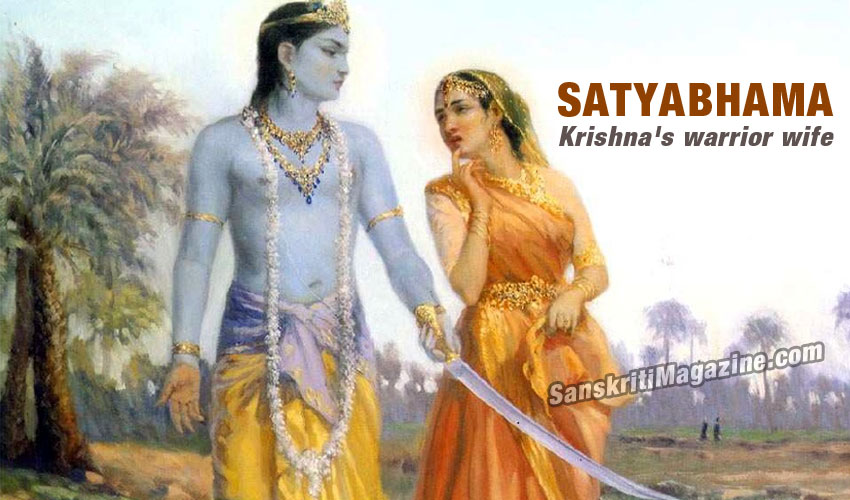Satyabhama is a very prominent character familiarized with the classical dance form of Kuchipudi. The pride of the womanfolk, the enchanting and coy, daughter of the very rich samanta king ‘Satrajith’ has always been the first love for ‘Sri Krishna’.
Satyabhama had all those characteristics that are expected out of a woman in all times. She proved her valour when she protected Sri Krishna and herself handled the bow and arrow to kill Narakaasura. After this event when she goes along with Krishna to meet Indra, as a mark of honour, she was given the divine ‘jada’ or the ornament used to decorate the long braid. This was the ‘jada’ that was once used by ‘Mohini’ in her incarnation as a motherly figure to save the celestial beings by giving them the ‘amrutam’ and cheating the demons, hence protecting the good and destroying the evil. Having given the ‘jada’ was to call her equal to that motherly figure and entrusting an added responsibility onto her. Her uncomparable love for her lord ‘Sri Krishna’ got her very possessive and she would try multiple means to have her lord just to herself.
 No wonder this unique character caught the thoughts of the saint ‘Siddhendra’ who wanted to propagate the jeevatma and paramaatma tatva, even among the lay people. Natya being the most attractive and communicative medium, was chosen as the ground to present the idea. No Natya is possible without a suitable literature. Therefore a ‘Kalapam’ which is a ‘uparupakam’ of ‘Sri Gaditam’, mentioned in the ‘Dasarupakas’ by sage ‘Bharata’ in his Natya Sastra, was chosen as an apt style of prose. Telugu literature with all its glory and decorative ‘padyams’ was chosen as the suitable language for the region. The boys from the Bhagavatulu families used to practice and teach dance for their livelihood. These boys being disciplined about the vedic deeds and having knowledge and divinity, were rightly chosen to perform this play. Saint Siddhendra himself wrote and composed the lyrics. The three charecters chosen for this play were—Sri Krishna, Satyabhama and Madhavi. Madhavi was a trans-gender and a close friend of both Krishna and Satyabhama. Saint Siddhendra had taken a poetic license of having created this story of quarrel between Sri Krishna and Satyabhama. This story is not found in any Puranas or Upa-Puranas. But the popularity is so high that it is better known to people than any other stories from the Puranas.
No wonder this unique character caught the thoughts of the saint ‘Siddhendra’ who wanted to propagate the jeevatma and paramaatma tatva, even among the lay people. Natya being the most attractive and communicative medium, was chosen as the ground to present the idea. No Natya is possible without a suitable literature. Therefore a ‘Kalapam’ which is a ‘uparupakam’ of ‘Sri Gaditam’, mentioned in the ‘Dasarupakas’ by sage ‘Bharata’ in his Natya Sastra, was chosen as an apt style of prose. Telugu literature with all its glory and decorative ‘padyams’ was chosen as the suitable language for the region. The boys from the Bhagavatulu families used to practice and teach dance for their livelihood. These boys being disciplined about the vedic deeds and having knowledge and divinity, were rightly chosen to perform this play. Saint Siddhendra himself wrote and composed the lyrics. The three charecters chosen for this play were—Sri Krishna, Satyabhama and Madhavi. Madhavi was a trans-gender and a close friend of both Krishna and Satyabhama. Saint Siddhendra had taken a poetic license of having created this story of quarrel between Sri Krishna and Satyabhama. This story is not found in any Puranas or Upa-Puranas. But the popularity is so high that it is better known to people than any other stories from the Puranas.
The characters were very rightly and carefully chosen. The portrayal of the characters is also very symbolical. Every gesture made by these characters and every dialogue said have a very in-depth meaning and abiding by the societal norms for centuries. Even today we can relate to many of the gestures made by the characters in this ‘Kalapam’
The usage of a trans-gender to unite the ‘stree’ and the ‘purusha’ has a very vedantic approach. It is to say, the gender which is related to the body has no significance while presenting oneself in front of the almighty. A trans-gender is the one who can think both like a man aswell like a woman, so can understand both of their emotions and advise them in need. This is also to ensure an acceptance of these trans genders in our society, who are sometimes looked upon.
The story revolves around the prime principle ‘Eko Purushah Narayana’, which means lord Narayana is the only Man and all other god’s creations are the woman, longing to unite with their master. In this story, the ‘jeevatma’ in the form of a woman- Satyabhama, is longing to unite with the ‘Paramatma’ or the only Man– Krishna. But this unity is possible only when the ego is completely removed out of the human being. To remove ego out of Satyabhama, Madhavi is put to action in this play. Satyabhama- after a long dialogue with her friend, is able to shed off all her ego step by step, final step being doing away with her nose pin, which was not supposed to be removed by a woman until her death, as per the societal norms in those days. Over the advice of Madhavi, Satyabhama then writes a letter to her lord, requesting his forgiveness for the quarrel that she started and pleading him to come back and unite with her.
Volumes can be spoken about the character ‘Satyabhama’ who is the prime subject and character of this play. This character gives ample scope for the dancer to exhibit every aspect of the Satvika abhinayam, thus proving to be pretty challenging. All the ‘Ashta vidha Srungara Nayikas’ can be portrayed through this character. An added pinch of arrogance to the character, is the imagination of ‘siddhendra yogi’ which adds more scope for abhinaya to the dancer and makes it more  colourful. This arrogance is actually far from reality and so should be used wisely by the dancer. Satyabhama is a personification of beauty and intelligence. She is brave and can even fight a war. She comes from a noble family and hence is very dignified. Above all, she is the first love of Sri Krishna, which even makes her proud and a little arrogant. Therefore, care should be taken by the dancer to bring out all moods of the character and not arrogance alone.
colourful. This arrogance is actually far from reality and so should be used wisely by the dancer. Satyabhama is a personification of beauty and intelligence. She is brave and can even fight a war. She comes from a noble family and hence is very dignified. Above all, she is the first love of Sri Krishna, which even makes her proud and a little arrogant. Therefore, care should be taken by the dancer to bring out all moods of the character and not arrogance alone.
Saint Siddhendra is dated to have lived in the 16th century. This work of his, has lasted for more than five centuries and is still ever-green. Such is the greatness of this work. Many quotes from this are still found relavant in our society. For example—Satyabhama says in an occasion:
‘mullu vachi aritaaku meeda padda, aritaaku vachi mullu meeda padda aritaakuke mosamu kada’
This literally means, whether a thorn falls on a leaf or a leaf falls on a thorn, it’s the leaf which faces the loss. Here the leaf is compared to a woman and the thorn to a man. When seen a situation where a woman falls prey to the wrath of a man, even today this dialogue seems so true. But there can be many interpretations to that dialogue which can mislead the audiences who don’t understand the language well. Similarly a man dancing a female role, that too a role like Satyabhama, gives him an in-depth understanding of a female psychology, which helps these men to empathise and respect the womanfolk better. Only an outwardly approach to the character can misguide the performer and the audience, leading to wrong-understanding and misconceptions.
In the five centuries that this ‘Bhama-Kalapam’ survived, the story has been adopted by different dancers and performed in varied forms. ‘Bhama-Kalapam’ is today danced as a part of ‘Andhra Natyam’, a different version is seen in the ‘Turpu Bani’ etc. Many changes in the language, literature and dialogues have been brought in with changing times, catering to the then audiences. These changes have brought in changes in the characteristics of ‘Satyabhama’. Therefore we today cannot generalize ‘Satyabhama’, but the portrayal by each individual dancer, is their personal Satyabhama. Some portray her as glamorous, some as arrogant, some try making her attractive to the connoisseurs, hence trying to make their living.
To conclude—The art which does not help in the betterment of a society is a waste. The art should be entertaining, educating and informative to the audience. Therefore care should be taken while handling great works of great people. The teachers need to learn enough to teach righteousness and right things to the students. Once a particular art is given the stature of classical, the classicism should be maintained throughout, including the language, literature and the portrayal of the character on the stage. There is a ‘Satyabhama’ in every house, waiting to get its share of due recognition and respect. A true pride of the womanfolk ‘Satyabhama’ deserves all our regards. Long live ‘Satyabhama’.
~ Padmavani Mosalikanti (MA- Kuchipudi dance & Hindi literature), Asst. Director ‘Shivamohanam’ trust (regd)










